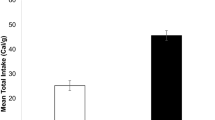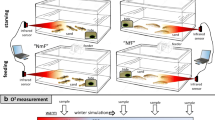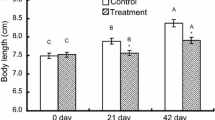Abstract
Most fish species are regularly subjected to periods of starvation during which a reduction of energy turnover might be favourable for the animal. This reduction of energy flux may be achieved by changes in thermal behaviour and/or swimming activity. We investigated such behavioural changes during starvation and subsequent refeeding in roach, Rutilus rutilus, with respect to energetic benefits and growth maximisation. Roach, acclimated to a wide range of temperatures (4, 12, 20, 24, 27 and 30 °C), were fed to excess, subjected to 3 weeks of starvation and subsequently refed in order to determine the temperature dependence of feeding rates, growth rates and conversion efficiency (K1) under control conditions and during compensatory growth. When exposed to a thermal gradient, control animals preferentially selected a temperature of 26.8±0.9 °C, which is in the range of the optimal temperatures for feeding, growth and conversion efficiency. Starving fish showed a distinct circadian pattern of the mean selected temperature (MST). They migrated to cooler water in the dark (MSTdark=22.8±1.1 °C) but returned to warmer water during daytime. This behaviour may be regarded as a trade-off between the potentially higher food density in warmer water areas and the energetic benefit of selecting cooler water patches. The circadian pattern of MST was gradually abandoned upon refeeding and control values were reached again after 3 weeks. Energetically more effective than behavioural hypothermia was the reduction of swimming activity. During starvation, activity peaks were slightly lower than under control conditions and mean daily activity decreased by about 50%. Swimming velocity, however, was not affected by feeding regime. After a period of starvation fish showed compensatory growth at all temperatures, even below 12 °C, where these animals normally do not grow. This suggests that after a period of starvation the critical temperature for growth shifts to lower values.
Similar content being viewed by others
Author information
Authors and Affiliations
Additional information
Electronic Publication
Rights and permissions
About this article
Cite this article
van Dijk, P., Staaks, G. & Hardewig, I. The effect of fasting and refeeding on temperature preference, activity and growth of roach, Rutilus rutilus . Oecologia 130, 496–504 (2002). https://doi.org/10.1007/s00442-001-0830-3
Received:
Accepted:
Published:
Issue Date:
DOI: https://doi.org/10.1007/s00442-001-0830-3




